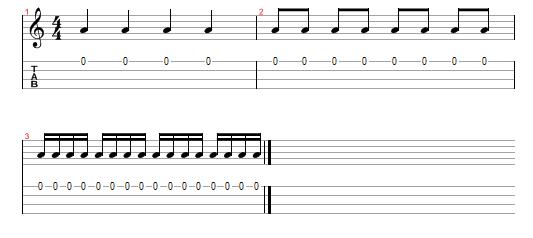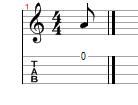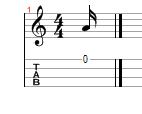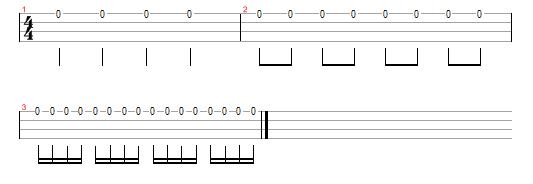Rhythm
Tabs vary with how much information they give about rhythm. Some tab you’ll see won’t have any rhythm indicated at all and will expect you to get the rhythm by listening to a recording. Some will have a vague indication of rhythm given by the distance between notes. Some will have tab and standard notation with the standard notation giving the rhythm. And some will have rhythm lines on the tab.
Rhythm in Standard Notation
Quite often you’ll see ukulele tab accompanied by standard notation. In these, cases the rhythm will be shown on the standard notation.
When you listen to a piece of music, you’ll feel the pulse of the music. Clap along with any song and you’ll be clapping out its beat. Each of these beats is known as a ‘crotchet‘ or ‘quarter note‘ and is written like this:
The lines going up in this example can also go down. It makes no difference to how the note is played.
In the examples, there is a click in the background for each beat (quarter note). You can count along with these in your head (or out loud) as 1, 2, 3, 4, 1, 2, 3, 4.
Half notes (or minims) last twice as long as and are shown as a line with a hollow circle at the bottom (the first half of the example 2). When you’re counting these, only play every other number. In this example you’d play on the 1 and the 3 (1, 2, 3, 4, 1, 2, 3, 4).
Whole notes (or semibreves) last twice as long as half notes. They are indicated by a hollow circle without any lines at all (the second half of Example 2). These notes are only played on the 1 ( 1, 2, 3, 4, 1, 2, 3, 4)
Going in the other direction, notes that are shorter than half notes look like this:
The first part of example 3 is quarter notes.
This is followed by a set of eighth notes (or quavers). These last half as long as quarter notes and look like two eighth notes connected by a horizontal line. These are usually counted ‘1 and 2 and 3 and 4 and’.
Eighth notes aren’t always in pairs and you’ll see single eighth notes singly where they are shown like this:
The final set of notes in example 3 shows sixteenth notes (or semi-quavers). These last half as long as eighth notes and are shown with a double horizontal line. These are usually counted ‘1 e and a 2 e and a 3 e and a 4 e and a’.
Again, these can be shown singly like this:
If you listen to the last example, you’ll hear a click for each quarter note. There are two eighth notes for each quarter note and four sixteenth notes per quarter note. Get used to counting out the eighth and sixteenth notes in your head or tapping out the rhythm before you try to play them.
You can keep halving the length of notes (adding an extra horizontal line each time) but it’s rare you’ll see anything shorter than a sixteenth note in ukulele tab.
Rhythm in Tab
Sometimes standard notation isn’t shown along with the tab. In these cases, the rhythm is usually indicated on the tab itself. This method isn’t quite so standardised. The system shown here is the one I use on Uke Hunt. Other systems may differ but will probably have similarities.
In tab, quarter notes are indicated by a line going down from the bottom. Example 1 would look like this when written in tab.
Half notes are shown with a shorter line under the tab and whole notes are shown with no line at all. Example 2 looks like this when written in tab.
Eighth and sixteenth notes are written in a very similar way as they are in standard notation. Example 3 would be written like this.
Bars/Measures
You might have noticed in that vertical lines (known as bar lines) in the tabs dividing the music into sections. Each of these sections is called a bar or measure. This makes it easier to follow and easier to reference a particular part of the tab.
The length of the bars is determined by the two numbers at the beginning of the tab (known as the time signature). In every case so far, this has been 4/4. That means there is the equivalent of four quarter notes in each bar. This could mean a half note and four eighth notes; or a quarter note, four sixteenth notes and four eighth notes; or any combination that adds up to four quarter notes.
Another common signature is 3/4 – known as waltz time. This means there are three quarter notes in each bar. It’s very rare that you’ll come across a time signature other than these..
.
Read the rest of the series here: How to Read Ukulele Tab.
This series was derived from my ebook Ukulele 101: 101 Things Every Ukulele Player Needs to Know.












solid gold
thx:)